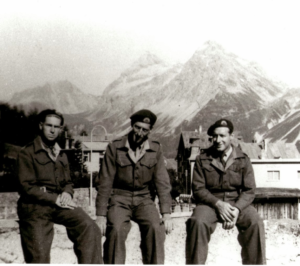Carl Carrigan
(1913-1989)
Gunner, 2/3rd Anti-Tank Regiment, Australian Army

Ron Fitzgerald, Paul and Carl Carrigan after crossing the Alps, in Switzerland. October 1943.
Carl, with his brother Paul and his friends Ron Fitzgerald, Ron MacIntosh, and Lloyd Ledingham, enlisted in 1940. He wanted to live an adventurous life and do something for his country, Australia. He was 27 at the time and had never been to another country. He left Sidney on 14 November 1940, heading for the Middle East.
He was captured on 9 April 1941 in Libya while he was fighting with some Indian troops near Mechili. They were brought to Derna and soon after to Benghazi, where he was handed to the Italians. After a week in awful conditions (there was little food, no shelter from the sun, and the PoWs suffered from dehydration and dysentery), he was loaded with other prisoners on a truck. Four days later, he was in Sabratha, a camp 60 km west of Tripoli. It was the end of April.
At the beginning of May, he was shipped to Naples on the Rialto. After a brief stay at PG 66 Capua and PG 78 Sulmona, he was moved by train on 17 July 1941 to PG 118, Prato all’Isarco, an old brewery converted into a prison camp.
In the brewery now turned prison camp, Carl proposed a training regimen to help his fellow PoWs to endure the harshness of prison life. He found an empty room that he used to conduct training sessions, following the Don Athaldo method, which he had used in precedence to strengthen his own relatively small body. He convinced the other PoWs to participate in these sessions, too.
In the camp, he also met Giovanni Cotta, a priest, and thanks to him, he was able to send news about his condition to his family, who had lost all traces of him.
In October 1941, after the closure of PG 118, after three months of imprisonment in relatively good conditions, Carl and the rest of the Australian prisoners were sent to PG 57, Grupignano. They remained there for 18 long months.
Under Calcaterra[1], living conditions in Camp 57 were extremely harsh. The food was poor quality, and the accommodations were crowded and unhygienic. Prisoners had to improvise their medical services […].
There were roughly 60-80 huts, and people slept eight in a single bed (four on the top bunk and four on the bottom). To compensate for the lack of blankets, men slept huddled together. Each hut had a small central stove, but the prisoners had only a limited quantity of wood. They burned the empty Red Cross Parcels and everything they could find […].
In the beginning, Red Cross Parcels, instrumental for the prisoners’ survival, arrived once every three weeks; however, as time passed, those containing canned food started to arrive only once every five months […].
In April 1943, Carl and his companions finally got a bit lucky. Since the Italians were running low on workers for the fields, they decided to use enemy PoWs instead. For this reason, Carl’s group was transferred from Grupignano to a farm in the Selve area, a few kilometres away from the city of Vercelli, a working detachment of PG 106 (which comprised 29 detachments, one for each farm or agricultural estate).
Workdays started at six in the morning, breakfast was served at seven, and then the prisoners had to walk for half an hour to their workplace. They returned to their accommodation for lunch and then had to work in the fields from 2 pm to 6 pm before returning to the farmhouse to eat dinner, usually pasta and vegetables. Meat and cheese were given to them twice a week, and a loaf of bread accompanied each meal. As workers, their ration was integrated with anything they could find lying around the farm.
Here, on 8 September 1943, Carl was informed of the Armistice and celebrated the news with the other prisoners and the guards, who immediately abandoned the camp, fearing they could be sent to the Russian front by the Germans.
In the following days, the prisoners remained at the farmhouse (without working), waiting for news. Soon, however, they learned that the Germans had warned that whoever helped escaped PoWs would be shot. This news and the contacts someone established with local partisans convinced them to leave after a few days, heading towards the Pennine Alps to cross the border between Italy and Switzerland.
Carl, Paul, Lloyd, Ron Fitzgerald and Ron MacIntosh reached the nearby area of Tabalino-Crova, where they stopped for a few days, aided by the population.
On 19 September, as the Germans were closing in on the area, they learned that that night a group of PoWs was to gather in the village of Selve to then depart for Arro, near Salussola. As they were preparing to leave, the people of Selve, who had grown attached to them, rushed to say goodbye, bringing them eggs and other food which they ate immediately. After dusk, the five left the village, guided by two Italians who went out as their vanguard. They marched for nine hours under heavy rain and without food.
During the march, they stopped near the hut of Pista Nuova, where the locals brought them polenta and milk. It was their first meal in days. After two days of respite, they were joined by the remainder of their group: almost 140 escaped PoWs, 50 of them carrying weapons. They also brought a horse and a cart full of machine guns.
The group leader was Pietro[2],
a former smuggler who guided them to the base of the mountains north of the Po Valley. As the group was huge, the operation was quite complicated. They walked at night and rested during the day. Their first stop was at Vermogno, on the hills near Biella. While they were resting in a barn, however, they were caught by the Germans. Only Carl and four of his companions managed to escape, while Ron MacIntosh and many others were captured. The group thus splintered and dispersed.
During the following days, they were helped by a girl who got them on to the last car of a tram headed to Biella. The girl sheltered them at her house on the city’s outskirts and, the following day guided them to the nearby hills and to a big house, where they found respite and shelter. When they woke up the next day, however, the girl and the Italians who were with her had disappeared.
After some rest, they decided to leave alone and reach the Oropa sanctuary, roughly seven kilometres north-east of Biella, as they knew some partisans had established a base there, and they had ammunition and food. However, along the way, they ran into a New Zealander who informed them that the Italians had blown up all the ammunition and the storage and that there was a German vehicle near the sanctuary. Thus, they changed their plan, heading north, hoping to cross the mountain passes before the winter snow would block them completely, and to escape to Switzerland.
On 29 September 1943, they descended into the valley after three days without food. When they entered a village, a group of kids, intrigued by their presence, surrounded them and brought them to the village’s square. Here, they were greeted by the inhabitants, who brought them food. After the meal, they left again, resuming their journey and stopping at an abandoned hut to rest.
On 2 October, they climbed to the top of Mount Turlo. They then descended to the other side and headed to the village of Quarazza, near Macugnaga.
In the woods outside the village, they ran into their saviour, a sixteen- or seventeen-year-old boy who agreed to guide them to Switzerland in exchange for their coats and watches. He was a brave boy whose brother had been shot by the Germans for guiding a group of escaped PoWs to Switzerland across the Alps.
Fearing the Germans, who were nearby, the boy guided them to a woodshed where they spent the night. The next day, he came to them, bringing each man a boiled potato and something to drink.
On 3 October, at 2 am, the boy reappeared to guide them. He brought spiked boiling coffee to warm and encourage them, as it was bitterly cold and pitch black around them. They climbed the rough slope of the mountain, cutting through a pine wood to make it easier to climb the hill.
The morning light saw them in the upper part of the pine wood, which was covered by snow during the winter. The boy was as agile as a mountain goat, and only Carl could keep up with him.
After reaching the pine wood’s limit, their guide told them he would go no further. Otherwise, the Germans would spot him with their binoculars when he returned to the village. However, he pointed to the mountains and told them: “That’s Switzerland”. They were at three thousand metres of elevation [probably on Mount Moro] as they crossed the snowfields that whitened the path leading them towards neutral country (Switzerland).
As they reached the border, they donned their battledresses so the border guard would recognise them as escapees and take them in.
Carl, Paul, Lloyd, and Ron Fitzgerald remained in Switzerland until 27 October 1944. They were repatriated a month later.
Once back in Australia, Carl worked as a breeder and a farmer until his death. He always kept in touch with his fellow escapees, with whom he shared the years of the war and the perils of the escape.
Camps related to this story
Sources
Australian War Memorial – https://www.awm.gov.au/collection/P11061115
C. Carrigan, Un’odissea in tempo di guerra. La storia di Carl Carrigan, soldato australiano, «L’impegno. Rivista di storia contemporanea del Vercellese, del Biellese e dal Valsesia», a. 23, n° 1, giugno 2013, pp. 33-51.
Italy to the Alps in WWII [blog by Cate Carrigan] – http://italytothealps.blogspot.com
Note:
[1] Emanuele Vittorio Calcaterra, a rabid Fascist, was commander of PG 57.
[2] He was most likely Pietro Camana, who later became commander of the Vercelli Battalion (later 182a Garibaldi brigade). He was killed in combat on 1 February 1945.
